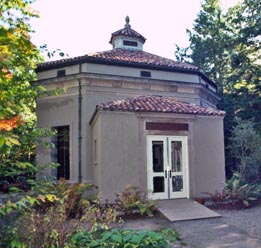On my second day at Acadia, in the morning I went to the Sieur de Monts Spring. This spring is closely linked to the early history of Acadia National Park. While Mount Desert Island has been occupied periodically since the early 1600s, the area was not established as a national park until 1919. During the 1800s, Mount Desert Island was first a thriving economic area for farmers, lumberjacks, and fishermen, and later a refuge for artists and journalists who came to the island to spend time in the island’s “tranquil beauty”. As more people came to visit the island, several hotels were built there, and soon Mount Desert Island became a thriving vacation spot. However, in 1901 Harvard president Charles Eliot worried that the creation of the portable sawmill would result in the destruction of Mount Desert Island’s natural beauty, and started a nonprofit organization for the preservation of the island. In 1916, 6,000 acres of land that Eliot’s friend George Dorr had acquired became the Siuer de Monts National Monument. The Siuer de Monts Spring had been set up in the area in 1909. In 1919 the park became Lafayette National Park–the first national park east of the Mississippi–and in 1929 the park was re-named Acadia National Park; it is the only national park in the United States to have all of its land donated to the government.
There’s a lot to do near Siuer de Monts Spring; the National Park Service calls this area “the heart of the park”. I first visited the Abbe Museum, which is dedicated to educating visitors about the culture and history of Maine’s native Americans. The Abbe Museum actually has two branches, one near the spring and a larger branch in downtown Bar Harbor, but I only visited the Siuer de Monts branch. Inside the museum, there was a series of four interesting dioramas that showed what life was like on Mount Desert Island before the arrival of Europeans.

Abbe Museum, photo from Abbe Museum website
After I was finished at the Abbe Museum, I took a walk through the Wild Gardens of Acadia. While that may seem like a strange name for a small (less than one acre large) area of land in a sizable national park, the Wild Gardens of Acadia gives visitors a chance to walk through all of the park’s different plant communities in the same small area. The Gardens were extremely peaceful, and while I was there I got to do some birdwatching and saw many different specimens of the park’s birds. Acadia is known for being an extremely good park for birdwatching in; not only does it have common birds like ducks and blackbirds, but it is also the home of bald eagles and rare peregrine falcons.
On my drive back from the Siuer de Monts Spring area, I decided to drive up Cadillac Mountain. In order to get to the summit of the mountain, I had to drive up a very narrow, 3.5 mile long road, which was slightly nerve-wracking for me since I’m scared of heights. However, the drive was less terrifying, and significantly less spectacular than the view when I reached the top. At 1530 feet, Cadillac Mountain is not only the highest point in Acadia National Park, but also is the highest point on the entire North American Atlantic Coastline. The mountain was formed at about the same time that the rest of Mount Desert Island was formed, between 380 and 420 million years ago. As North America collided with the ancient Avalonian plate, it caused magma to move up through the crust, eventually bursting out into a gigantic magma bubble that cooled and became Cadillac granite. Cadillac granite is characterized by an abundance of feldspar, which gives it its signature pink color. This type of granite also contains quartz, hornblende, and biotite. Cadillac Mountain itself was carved after years of wearing down by glacial ice and exfoliation wore down its top until it was rounded, rather than pointy. The view from the top of the mountain was amazing: you could see clearly across the bay and could also see the nearby Porcupine Islands. It was definitely worth the drive on the way up.

View from Cadillac Mountain--photo from travelguideofamerica.com







